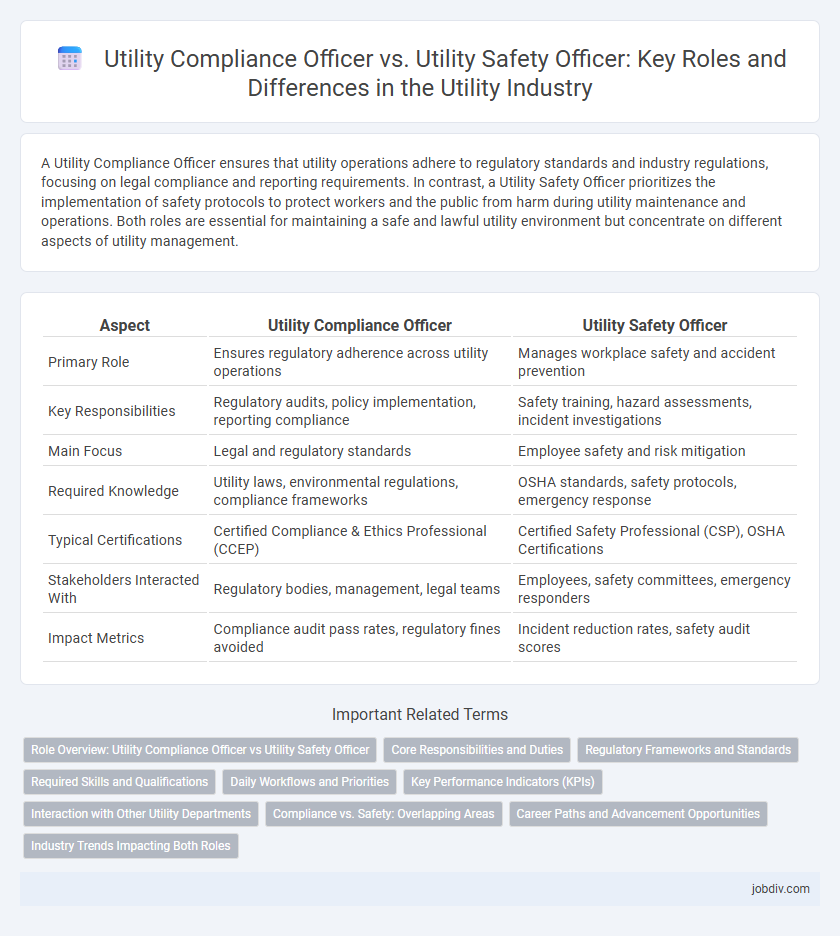A Utility Compliance Officer ensures that utility operations adhere to regulatory standards and industry regulations, focusing on legal compliance and reporting requirements. In contrast, a Utility Safety Officer prioritizes the implementation of safety protocols to protect workers and the public from harm during utility maintenance and operations. Both roles are essential for maintaining a safe and lawful utility environment but concentrate on different aspects of utility management.
Table of Comparison
| Aspect | Utility Compliance Officer | Utility Safety Officer |
|---|---|---|
| Primary Role | Ensures regulatory adherence across utility operations | Manages workplace safety and accident prevention |
| Key Responsibilities | Regulatory audits, policy implementation, reporting compliance | Safety training, hazard assessments, incident investigations |
| Main Focus | Legal and regulatory standards | Employee safety and risk mitigation |
| Required Knowledge | Utility laws, environmental regulations, compliance frameworks | OSHA standards, safety protocols, emergency response |
| Typical Certifications | Certified Compliance & Ethics Professional (CCEP) | Certified Safety Professional (CSP), OSHA Certifications |
| Stakeholders Interacted With | Regulatory bodies, management, legal teams | Employees, safety committees, emergency responders |
| Impact Metrics | Compliance audit pass rates, regulatory fines avoided | Incident reduction rates, safety audit scores |
Role Overview: Utility Compliance Officer vs Utility Safety Officer
Utility Compliance Officers ensure adherence to regulatory standards and internal policies by conducting audits, managing documentation, and coordinating with regulatory bodies to mitigate legal risks. Utility Safety Officers focus on implementing safety protocols, conducting risk assessments, and promoting workplace safety culture to prevent accidents and maintain compliance with occupational health and safety laws. Both roles are critical in maintaining operational integrity but differ in their emphasis on regulatory compliance versus proactive safety management.
Core Responsibilities and Duties
A Utility Compliance Officer ensures adherence to regulatory standards, audits operational processes, and manages documentation to maintain legal and environmental compliance within utility companies. A Utility Safety Officer focuses on hazard identification, risk assessments, and the implementation of safety protocols to protect workers and infrastructure from accidents and injuries. Both roles are critical for operational integrity but diverge in emphasis: compliance concentrates on following laws and regulations, while safety prioritizes workplace and public protection.
Regulatory Frameworks and Standards
Utility Compliance Officers ensure adherence to regulatory frameworks such as the North American Electric Reliability Corporation (NERC) standards and Environmental Protection Agency (EPA) regulations, focusing on legal compliance and reporting requirements. Utility Safety Officers concentrate on Occupational Safety and Health Administration (OSHA) standards and industry-specific safety protocols, implementing risk assessments and employee training to prevent accidents. Both roles are vital for utility companies to maintain operational integrity, meet government mandates, and safeguard public and worker safety.
Required Skills and Qualifications
A Utility Compliance Officer requires expertise in regulatory frameworks, risk management, and auditing skills to ensure adherence to industry standards and legal requirements. In contrast, a Utility Safety Officer must possess knowledge of occupational health and safety protocols, hazard identification, and emergency response procedures to maintain a safe working environment. Both roles demand strong communication skills and certifications such as OSHA, but compliance officers often emphasize legal and procedural qualifications while safety officers prioritize practical safety training and certifications like NFPA or HAZWOPER.
Daily Workflows and Priorities
Utility Compliance Officers focus on ensuring adherence to regulatory standards and internal policies, conducting audits, and managing documentation to mitigate legal risks. Utility Safety Officers prioritize identifying hazards, implementing safety protocols, and conducting training sessions to prevent accidents and promote a safe work environment. Daily workflows for Compliance Officers revolve around monitoring compliance metrics and reporting, whereas Safety Officers concentrate on site inspections and incident investigations.
Key Performance Indicators (KPIs)
A Utility Compliance Officer's KPIs typically include regulatory adherence rates, audit completion timelines, and incident reporting accuracy, ensuring utilities meet all legal standards. Utility Safety Officers focus on KPIs like workplace injury frequency, safety training completion rates, and hazard identification efficiency to maintain a safe operational environment. Both roles drive performance improvements but emphasize different metrics aligned with legal compliance and physical safety, respectively.
Interaction with Other Utility Departments
Utility Compliance Officers collaborate closely with legal, regulatory, and environmental departments to ensure adherence to laws and internal policies, facilitating smooth audits and regulatory reporting. Utility Safety Officers work directly with operations, maintenance, and emergency response teams to implement safety protocols and conduct risk assessments, minimizing workplace hazards. Both roles require effective communication and coordination to maintain regulatory compliance and promote a safe utility environment.
Compliance vs. Safety: Overlapping Areas
Utility Compliance Officers ensure adherence to industry regulations, focusing on legal and environmental standards, while Utility Safety Officers prioritize workplace safety protocols and accident prevention. Both roles overlap in monitoring risk management systems and conducting audits to uphold regulatory and safety requirements. Collaboration between these officers enhances overall utility operational integrity and minimizes legal liabilities.
Career Paths and Advancement Opportunities
Utility Compliance Officers specialize in regulatory adherence, ensuring companies meet local, state, and federal utility laws, often advancing to roles like Regulatory Affairs Manager or Compliance Director. Utility Safety Officers focus on implementing safety protocols and training to prevent workplace accidents, with career progression typically leading to Safety Manager or Environmental Health and Safety (EHS) Director positions. Both career paths offer advancement opportunities in technical expertise, leadership roles, and cross-functional management within utility companies.
Industry Trends Impacting Both Roles
Utility Compliance Officers and Utility Safety Officers both face evolving industry trends such as increased regulatory scrutiny, the integration of smart grid technologies, and heightened cybersecurity threats that demand proactive risk management. Enhanced data analytics tools enable Compliance Officers to ensure adherence to complex regulations, while Safety Officers leverage real-time monitoring systems to mitigate operational hazards. The shift towards renewable energy sources also requires both roles to adapt safety protocols and compliance frameworks to accommodate new infrastructure and environmental standards.
Utility Compliance Officer vs Utility Safety Officer Infographic

 jobdiv.com
jobdiv.com